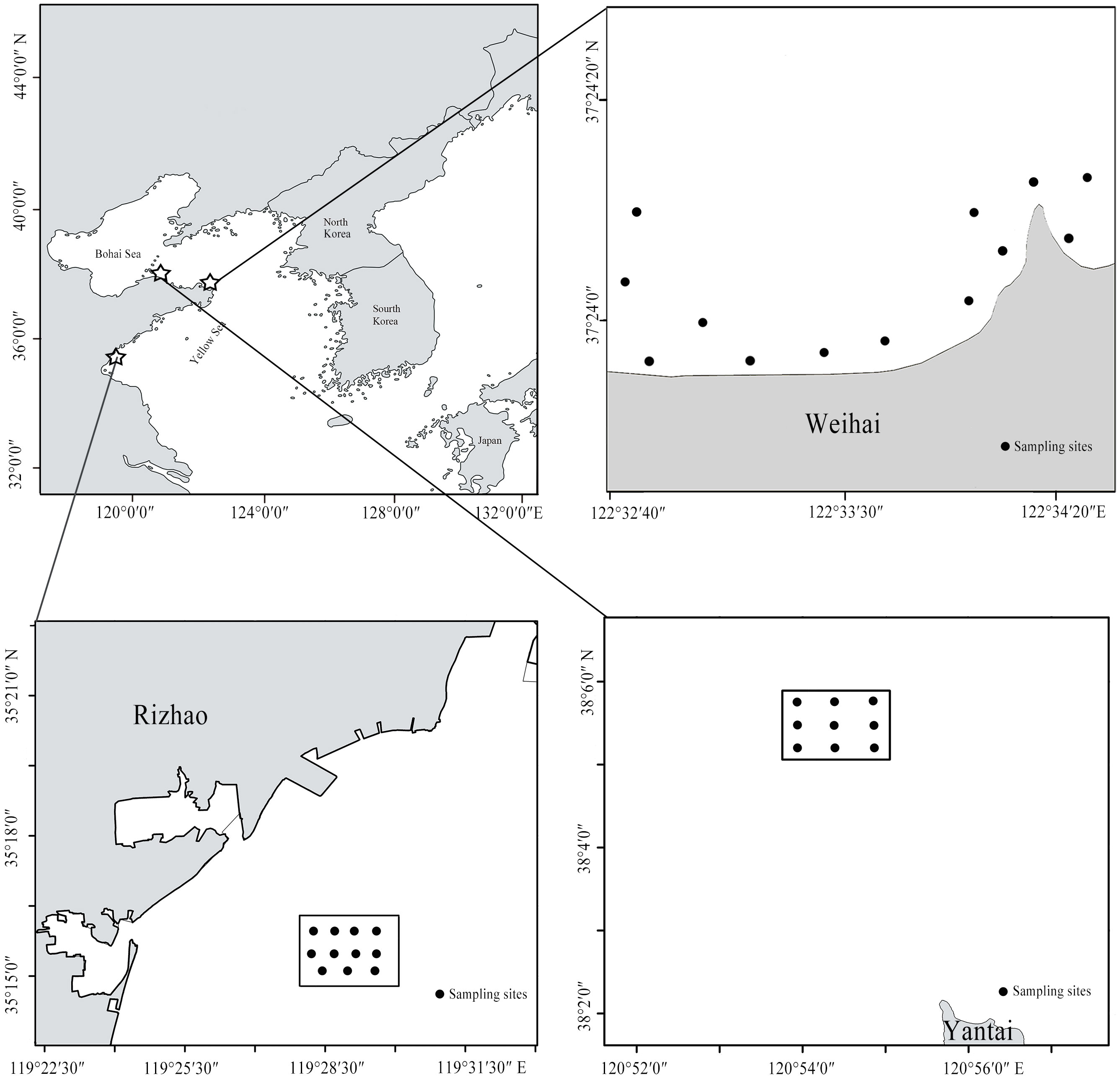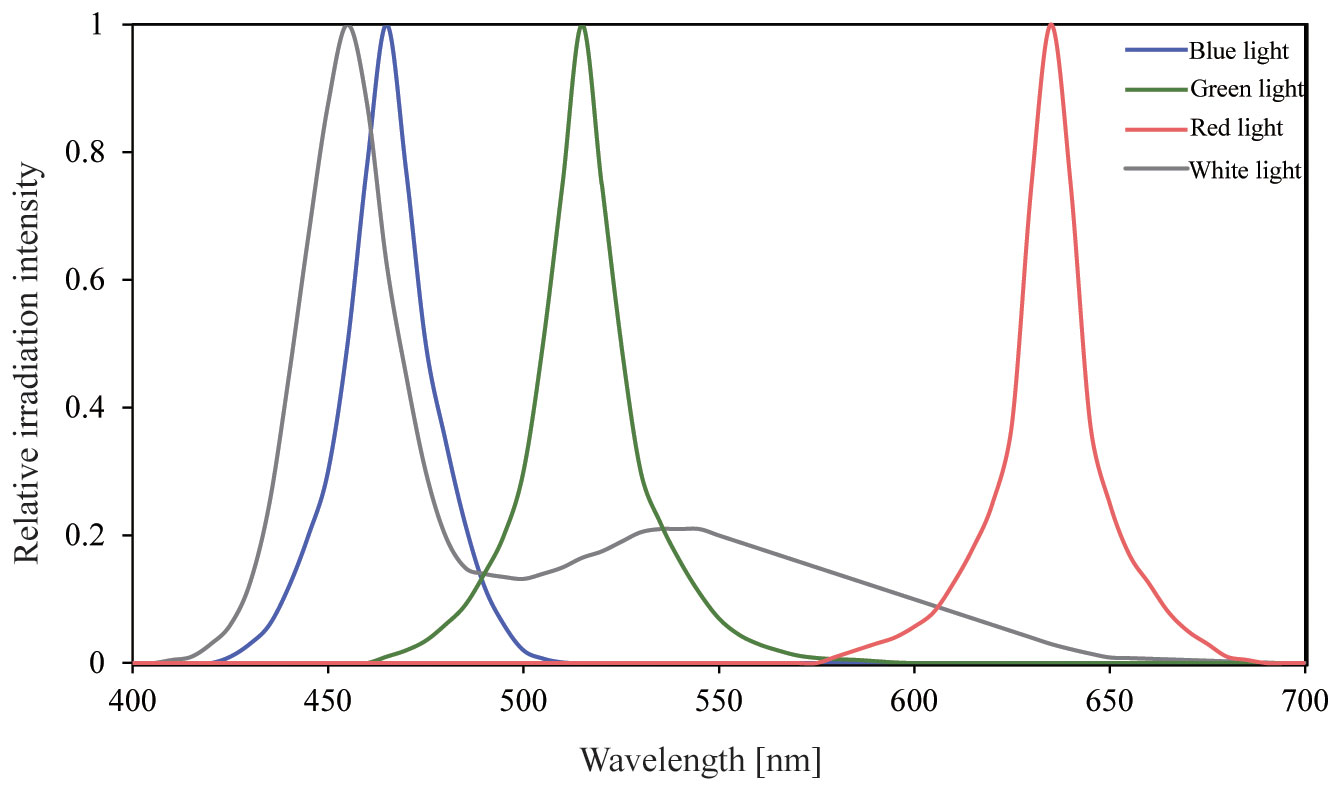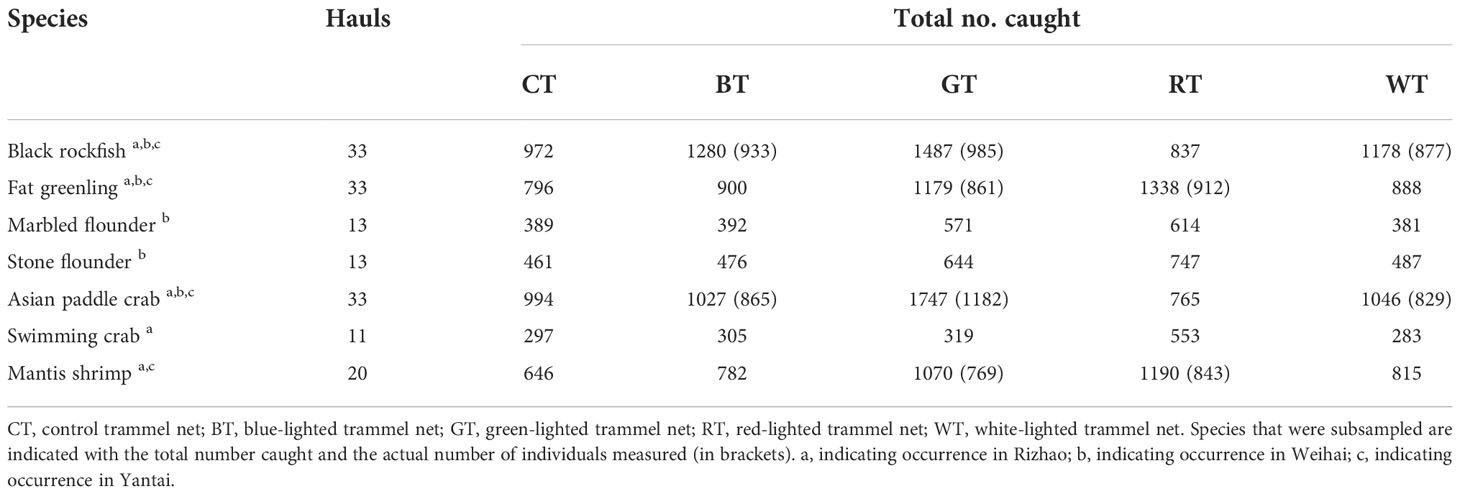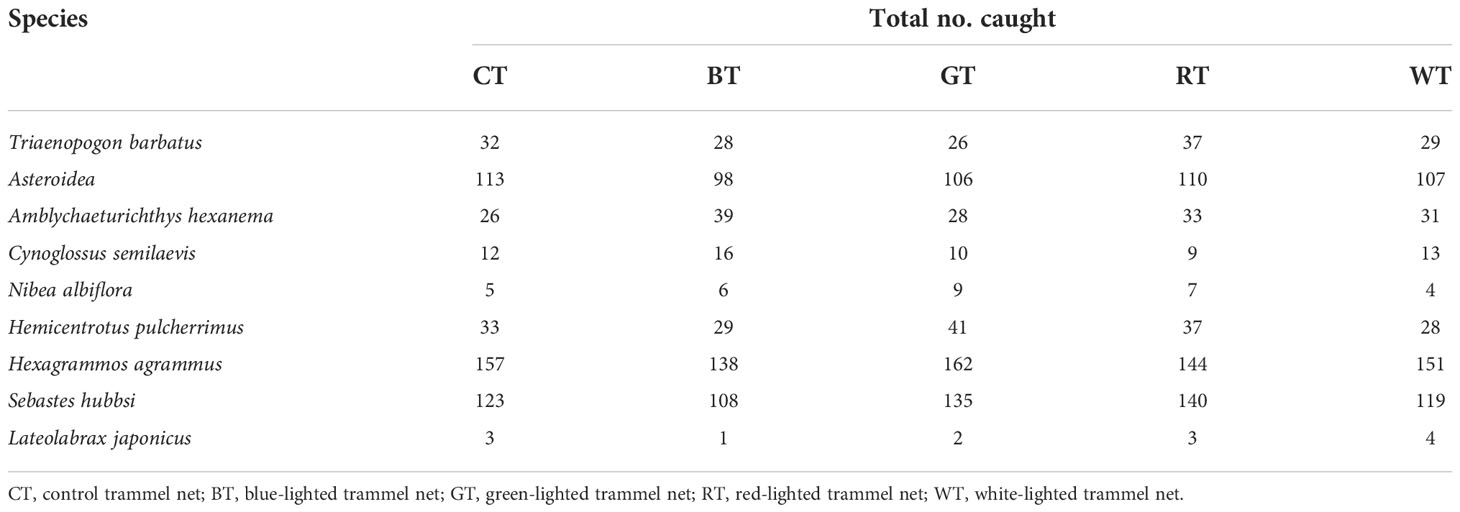- Fisheries College, Ocean University of China, Qingdao, Shandong, China
The small-scale trammel net fisheries are essential to the economy and well-being of coastal communities in the Yellow Sea, China. However, these fisheries are low efficient and urgently demand technical innovations to improve catch rates. In this study, we conducted field experiments in three traditional fishing grounds (Rizhao, Yantai, and Weihai) to test whether the addition of different colored light-emitting diodes (LEDs) fishing lights in the trammel nets could improve the catch rates of seven commercial species. Results showed that the effects of LEDs on catch rates were species-specific. Green LEDs could significantly increase the catch per unit effort (CPUE) of black rockfish (Sebastes schlegelii), fat greenling (Hexagrammos otakii), marbled flounder (Pseudopleuronectes yokohamae), stone flounder (Platichthys bicoloratus), Asian paddle crab (Charybdis japonica), and mantis shrimp (Oratosquilla oratoria) by 40%-72% compared with unilluminated nets, while had no significant effect on the catch rates of swimming crab (Portunus trituberculatus). Red LEDs harvested 58%-86% higher CPUE of fat greenling, marbled flounder, stone flounder, mantis shrimp, and swimming crab while catching fewer black rockfish and Asian paddle crab. Blue and white LEDs exhibited similar performance, which could significantly capture more black rockfish, fat greenling, and mantis shrimp and did not affect the catch rates of other species. The effects of LEDs were also size-dependent for certain species, and the catch rates generally increased with the length classes. Taking economic benefits into consideration, the green and red LEDs provided the highest profitability for Rizhao, while green LEDs performed best in Weihai and Yantai. This study is the first investigation on how artificial lights affected the catch rates of trammel nets. The findings of our study illustrated that trammel nets equipped with LEDs could serve as a viable fishing strategy in small-scale trammel net fisheries.
Introduction
Small-scale fisheries (SSFs) are of great socio-economic importance to coastal communities and provide work to 90% of the people employed in capture fisheries worldwide (FAO, 2020). SSFs accounted for 82% of the total fishing fleet (approx. 85,300 vessels) and 28% of the total power (approx. 3,242,700 kW) in 2021 in the Yellow Sea, China (Fisheries Administration Bureau, MARA, PRC, 2022). These small-scale vessels have an overall length of fewer than 12 m and limited power (< 44.1 kW), and fishing activities are mainly conducted in the coastal waters (distance to shoreline less than 10 km). SSFs are highly diversified depending on the seasonality of target species and the fishing gear used to capture them (Lucchetti et al., 2020).
Trammel net is a ubiquitous fishing gear used in the SSFs of the Yellow Sea, China, because of its ease of use and eco-friendliness. The commonly used trammel nets have a length ranging from 50 to 100 m, and several units of trammel nets were connected into a string in the fishing process. Trammel nets are passive fishing gear consisting of three panels of netting, two outer panels with a large mesh size, and an inner panel with a small mesh size. This design enables trammel nets to catch fish in two mechanisms: (a) gilling, wedging, and entangling, like gillnets, and (b) trapping fish in the bags of the inner netting (Karakulak and Erk, 2008; Kalayci and Yesilcicek, 2012; Gabr and Mal, 2016). Trammel nets are considered less selective than gillnets and characterized by mixed-species catch, including a wide range of benthic and pelagic species (Fabi et al., 2002). Traditionally, all catches were categorized into three groups by fishermen: target species (fishes with high commercial value), bycatch (fishes discarded), and others (fishes kept by the fishermen for consumption or retained for baits in other unrelated fisheries).
Trammel net fishery started in the 1970s in the Yellow Sea, China, and provided an important source of income, employment opportunities, food, and nutrition for more than 2000,000 people in the coastal communities which with few economic alternatives other than those related to fishing (Fisheries Administration Bureau, MARA, PRC, 2022). The landings of trammel nets have been increasing from 1979 to 2016 and occupied 20%-30% of the total marine landings (Li et al., 2019; Ma et al., 2021). In recent years, the annual total landing of trammel nets has stabilized at about two million tons (Fisheries Administration Bureau, MARA, PRC, 2017; Fisheries Administration Bureau, MARA, PRC, 2022). However, this commercial fishery is constrained by low catch efficiency, and the catch rates vary from 3.0 to 6.0 kg catches per unit of trammel net (Li et al., 2016). Local fishermen tend to increase the number of trammel nets and frequency of trips or move their fishing sites to resource-rich areas based on their experience to achieve higher catches. Nowadays, these traditional fishing strategies are difficult to achieve effective fishing due to the increased operating costs (e.g., fuel, nets, and labor). The profitability of this commercial fishery was reduced substantially (personal communication with fishermen). Meanwhile, extensive fishing activities captured a high proportion of juveniles with low-economic values, which brought negligible incomes for fishermen and was labor-consuming and time-consuming to handle (Sun et al., 2018; Yu et al., 2022). The current exploitation patterns have resulted in the input not being proportional to the output in the trammel net fishery, causing a financial strain on the coastal communities. Furthermore, a seasonal closure policy called “Summer Moratorium of Marine Fishing” (SMMF) was implemented by the Ministry of Agriculture (MOA) from May 1st to September 1st, indicating that fishermen have limited time to conduct fishing activities. Thus, it is imperative and urgent to find reasonable measures to improve catch efficiency to maintain the financial viability of coastal communities.
In the past decades, light-emitting diodes (LEDs) fishing lights have been applied in both the coastal and pelagic SSFs to improve catch rates or reduce bycatch and achieved promising results in some scenarios (See review by Nguyen and Winger (2019)). For example, adding white and purple LEDs into baited traps could significantly increase the catch per unit effort (CPUE) of snow crab (Chionoecetes opilio) by 77% and 47%, respectively (Nguyen et al., 2017). In gillnet fishery, LEDs have been used to reduce the bycatch according to the visual acuity of aquatic animals, including sea turtles, elasmobranch, Humboldt squid, and finfish (Wang et al., 2010; Wang et al., 2013; Ortiz et al., 2016; Darquea et al., 2020; Senko et al., 2022), while no practical applications were reported to improve catch rates of target species in gillnet or trammel net fisheries. The only piece of incidental information came from a local expert fisherman who harvested higher catches in trammel nets by artificial illumination in the Yellow Sea, China (personal communication with fishermen). Thus, systematically assessing how the LEDs affect the catch rates of trammel nets is essential to understanding the applicability of net illumination in this fishery.
In this study, we conducted the first scientific investigation into the application of LEDs in trammel net fishery. This study aimed to (1) preliminarily explore the phototaxis of target species in field experiments; (2) assess the effects of different colors of LED lights on the catch rates of trammel nets; (3) recommend an optimal color of LED lights in improving the catch rates of trammel nets.
Materials and methods
Sea trials
Sea trials were carried out in three traditional fishing grounds (Rizhao, Weihai, and Yantai) in the Yellow Sea, China, during the autumn of 2021 (Figure 1). These areas are typical representatives of small-scale trammel net fisheries and constitute an important segment of total landings. We conducted the sea trials for 11 days in Rizhao (September 6-16), 13 days in Weihai (September 26-October 8), and 9 days in Yantai (October 19-27) in collaboration with local professional fishermen. The substrate type of fishing area is a mixture of sand, mud, and rock, and the depth ranges from 5 to 30 m. The local commercial fishing vessels were used during the sea trials with a speed of approximately 3.0 knots. The sampling sites were selected based on seafloor topography and the recommendation of experienced local fishermen. In Weihai, the nearshore topography was complex, and many giant rocks were located on the seafloor, which could affect trammel net operation. Thus, the sampling sites were unevenly designed along the coast. The fishing grounds in Rizhao and Yantai were flat, so the sampling sites were evenly distributed (Figure 1).
Five trammel net treatments were set for the experiments: (1) trammel nets without LEDs as the control group (CT); (2) blue-lighted trammel nets (BT); (3) green-lighted trammel nets (GT); (4) red-lighted trammel nets (RT); (5) white-lighted trammel nets (WT). The net dimensions of CT were 50 m × 1.8 m, which are commonly used by local fishermen. The outer and inner panels were made of 0.30 mm and 0.12 mm mono-filament with hanging ratios of 0.54 and 0.40, respectively. The mesh sizes of the outer panel and inner panel were 330 mm and 60 mm (fully stretched mesh size), respectively (Figure 2). The float of trammel nets was composed of plastic foam, and the sinker was made of the lead block with each weight of 30 g. For the test group ((2)-(5)), the specifications of nets were identical to CT except for the addition of LEDs. The LEDs (manufactured by Zhejiang Underwater Fishing Light Factory) have a length of 15 cm, weight of 35 g, a forward voltage of 3.0 V, luminous intensity of 4.8 cd, forward current of 39 mA, and power dissipation of 136 mW. The lights have an illumination time of approximately 100 hours, depending on the type of AA battery used as a power source. These LEDs are cheap (8 yuan/light), energy-efficient and waterproof. The spectrum distribution of LEDs measured by Laser Spectrometer (UPPtek) is shown in Figure 3. Peak wavelengths were 465 nm for blue lights, 516 nm for green lights, 633 nm for red lights, and 456 nm for white lights. Ten LEDs were attached to the float line of each test group with nylon cable ties, with an interval of 4.85 m, and this configuration would not affect gear performance, such as floatability, due to the limited weight of lights. Fifteen trammel net units were used in each study area, three for each treatment. Each trammel net treatment was deployed 200 m apart enough to avoid the interactive interference of different color lights.
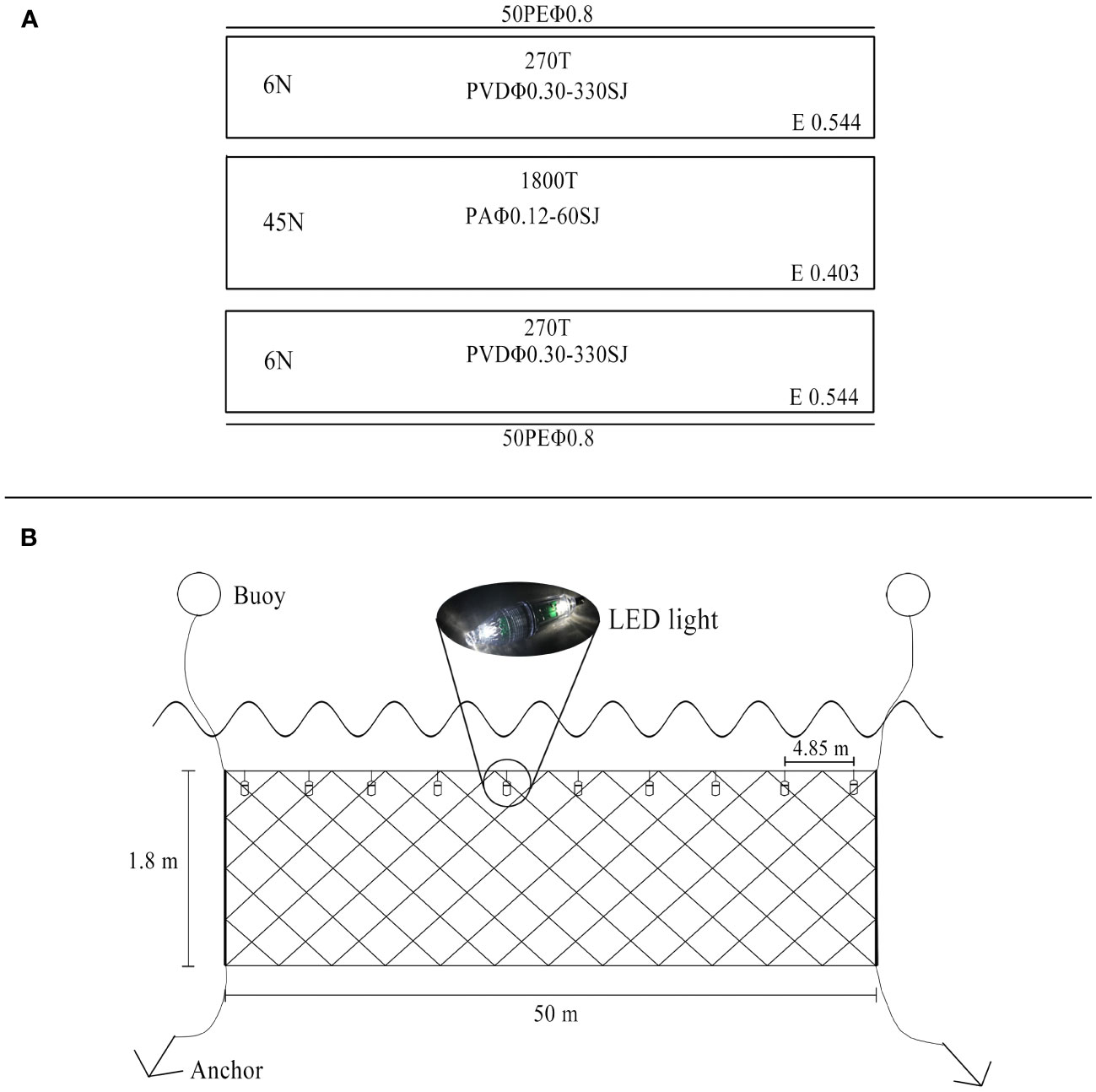
Figure 2 Schematic diagram of trammel nets. (A) Unfolded drawings of trammel nets. 6N, 45N, vertical mesh number; 270T, 1800T, horizontal mesh number; E, hanging ratio. PVDΦ0.30-330SJ, the outer panel was made of PVD monofilament with a diameter of 0.30 mm and had a mesh size of 330 mm. PAΦ0.12-60SJ, the inner panel was made of PA monofilament with a diameter of 0.12 mm and had a mesh size of 60 mm. 50PEΦ0.8, floating line and sinker line were made of polyethylene rope with a length of 50 m and diameter of 0.8 mm. (B) Operation mode of illuminated trammel nets.
We inspected all nets and LEDs carefully and replaced the broken ones before each trial. Trammel nets were set at twilight and hauled up in the morning of the following day after 12 h of soaking time, which is typical for trammel net fishery. After each trial, catches were collected and classified at species level. Fish species were measured for body length (BL) and total length (TL), and crustacean species were measured for carapace length (CL) and carapace width (CW) to the nearest mm. Each species was weighted to the nearest 0.01 g.
Statistical analysis
Generalized linear mixed model (GLMM) was used to estimate the effect of LEDs on catch rates with CPUE as an indicator. In our study, the soak time was mostly consistent between different deployments (mean=12.0 h; SD=0.16); thus, we defined CPUE as the total number of certain species captured per trammel net deployment. The response variable is CPUE, and the explanatory variable is trammel net treatment (categories with five levels: CT, BT, GT, RT, WT) and region (categories with three levels: Rizhao, Weihai, and Yantai). We had tested for the interaction between trammel net treatment and region but found it to be insignificant; therefore, we removed it from our final model. As the environments were not uniform across trips, we included trip ID as a random effect (random intercept), accounting for temporal variations in the environment (e.g., water temperature, weather). We initially used Quantile-quantile (QQ) plots to determine if errors were best fit with a normal, lognormal, Poisson, or negative binomial distribution (Harris et al., 2020). The negative binomial distribution was selected for our count data, and the log link function ensured positive fitted values (Eq. (1)). Likelihood was estimated with Laplace approximation based on GLMM fitting and inference protocols (Bolker et al., 2009). Analyses were conducted in R Statistical Software (R Core Team, 2018) using the LME4 package (Bates et al., 2017).
CPUE ~ Negative binomial (μ)
trip ID ~ N(0,σ2)
The analysis of the catch proportion of fish at length l retained by the test group (BT, GT, RT, WT) and CT was performed following the method described in Holst and Revill (2009). The statistical model used catch proportion Φ(l) as the response variable, which could be calculated by Φ(l)=n(l, test)/(n(l, test)+n(l, control)) , where n(l, test) and n(l, control) is the number of fish at l measured for the test group and CT, respectively, length l as the explanatory variable, trip ID as the random effect, and subsample ratio as offsets (Eq. (2)). This procedure was implemented with the “glmmPQL” function in the MASS package using a penalized quasi-likelihood approach. The analysis was preceded by fitting the highest order polynomials followed by subsequent reductions until all terms showed statistical significance (p<0.05).
In this model, a value of Φ =0.5 or confidence intervals (CIs) overlapping 0.5 indicates no significant differences in catch rates between test and control nets at each length class.
We used VPUE (value per unit of effort) to calculate the economic benefits of each trammel net treatment in three study areas to determine the optimal recommendation (Whitmarsh et al., 2008). The VPUE is defined as the total value of fish captured per trammel net deployment. The price of commercial species was acquired according to the seafood market survey (Table S1). The formula can be expressed as follows:
Where V is the total value of each trammel net deployment; S is the total number of categories of species; Wi is the weight of each species; Pi is the price of each species, measured in yuan/kg.
Pairwise Mann-Whitney (U) test was used to examine whether there was a significant difference in VPUE between different trammel net treatments.
Results
A total of 33 valid hauls were conducted, 11 hauls for Rizhao, 13 hauls for Weihai, and 9 hauls for Yantai (Table 1). The soak time varied between 11.7 and 12.3 h, and all LEDs functioned well at the end of each trip. The total weight of catches was 2748 kg. Sufficient data for analysis were collected for seven commercial species (Table 2): two roundfish species, black rockfish (Sebastes schlegelii) and fat greenling (Hexagrammos otakii); two flatfish species, marbled flounder (Pseudopleuronectes yokohamae) and stone flounder (Platichthys bicoloratus); three crustacean species, Asian paddle crab (Charybdis japonica), swimming crab (Portunus trituberculatus), and mantis shrimp (Oratosquilla oratoria). Five of these species occurred in Rizhao and Weihai, and four in Yantai (Table 2). The length distributions of seven commercial species are shown in Figure 4. The number of bycatch species was relatively low throughout the experiment. Table 3 shows the numbers of individuals captured by species and treatment, including Triaenopogon barbatus, Asteroidea, Amblychaeturichthys hexanema, Cynoglossus semilaevis, Nibea albiflora, Hemicentrotus pulcherrimus, Hexagrammos agrammus, Sebastes hubbsi, and Lateolabrax japonicus. There was no significant difference between different trammel net treatment (Kruskal-Wallis test, P > 0.05).
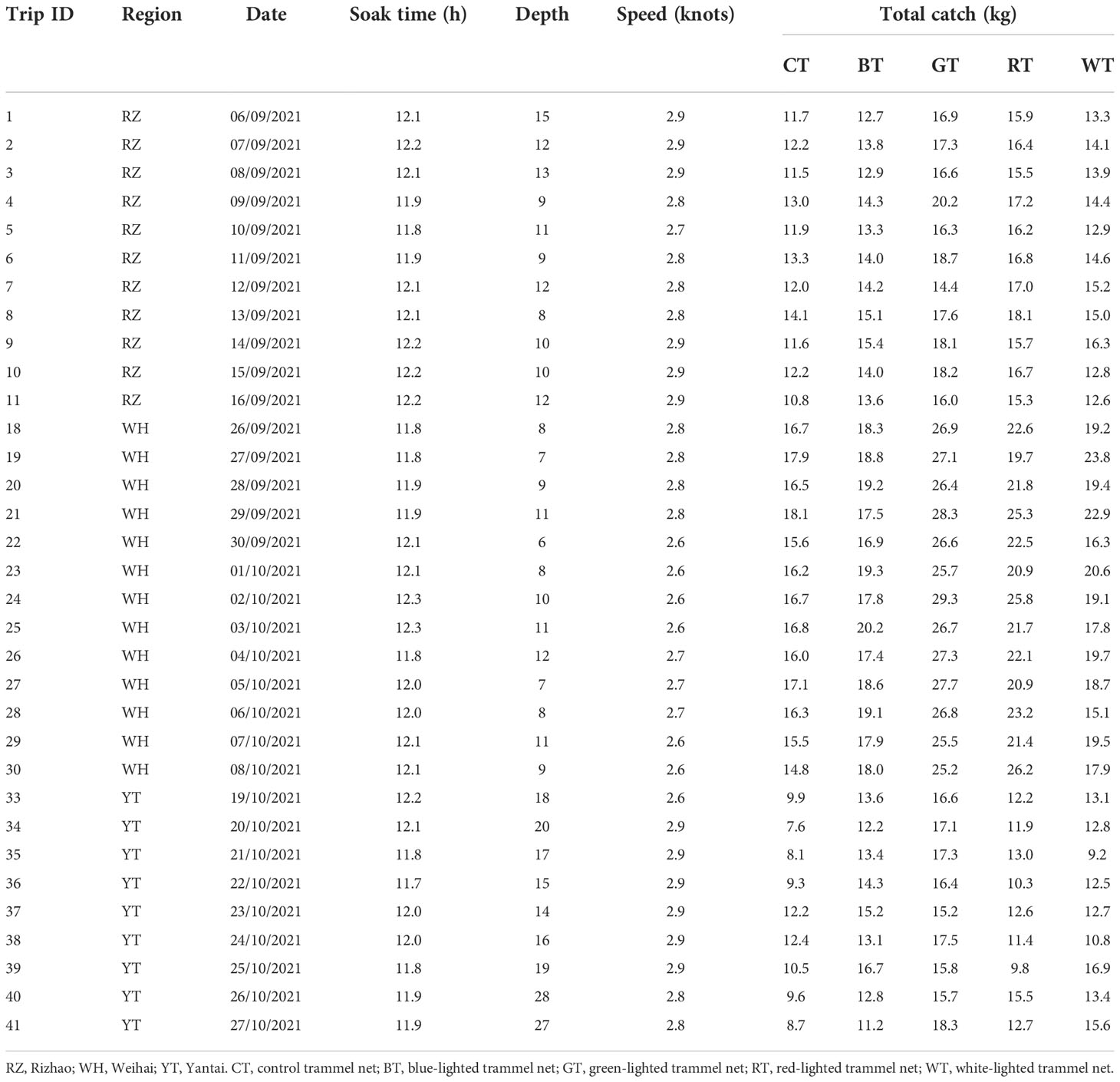
Table 1 Overview of the sea trials in the three fishing areas, showing the technical and environmental parameters, and total catch (kg) for each of the trammel net treatment.
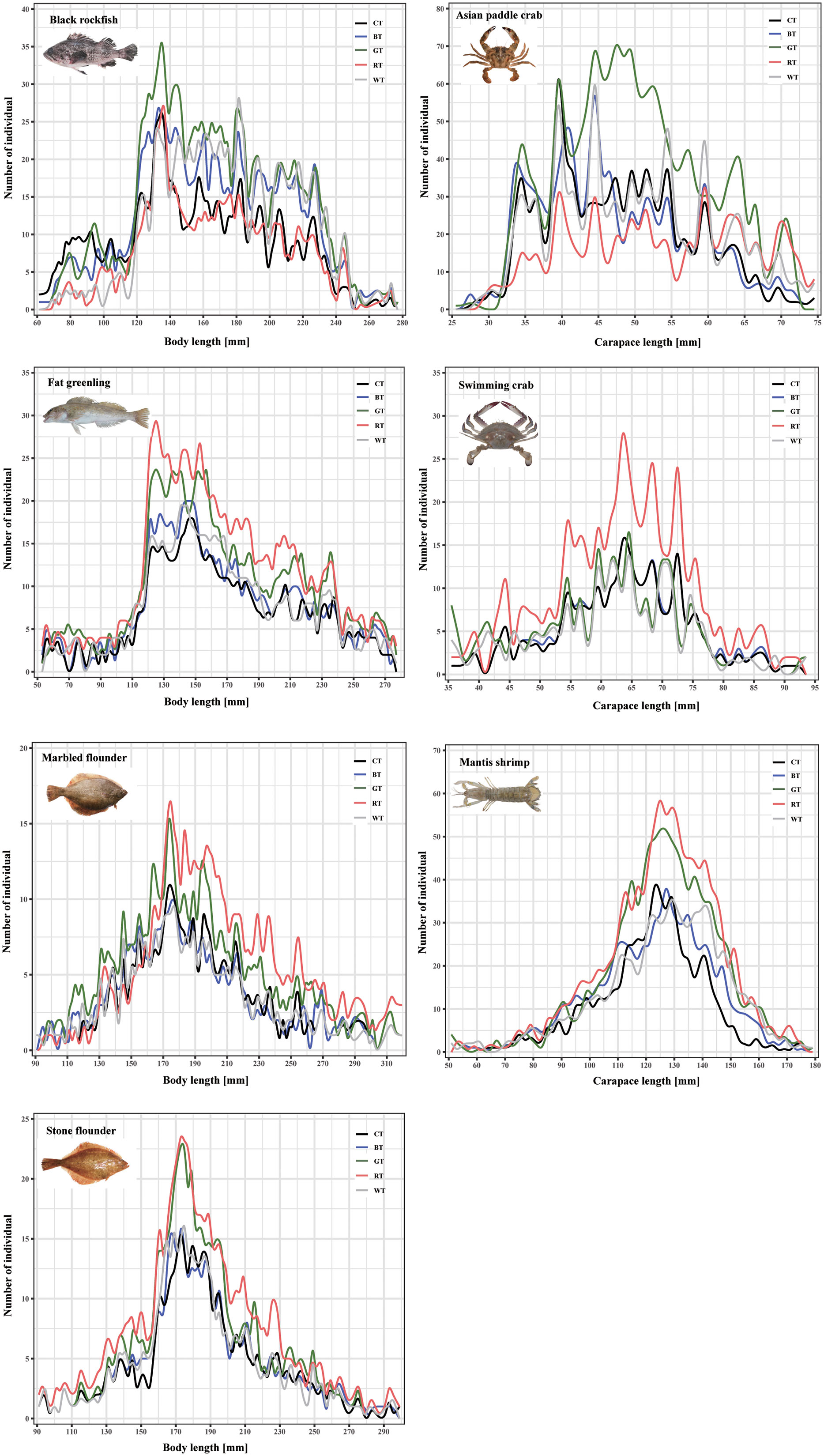
Figure 4 The body length and carapace length distributions of seven commercial species. CT, control trammel net; BT, blue-lighted trammel net; GT, green-lighted trammel net; RT, red-lighted trammel net; WT, white-lighted trammel net.
The fit statistics of the GLMM model are shown in Table S2 and Table S3. The effects of LEDs on catch rates varied between species and light colors. Meanwhile, there was some variability in catch rates between the three fishing grounds. No significant interaction was observed between trammel net treatment and region during the construction of the GLMM model. Therefore, despite the spatial variations in catch rates between regions, the CPUE of different trammel net treatments was not affected by the region. The GLMM-modeled proportions of seven commercial species captured at each length class are shown in Figures 5-7. The model parameters are shown in Table S4 and Table S5, and all parameters showed statistical significance (p<0.05). The detailed results for seven commercial species are hereafter presented separately to facilitate the interpretation of species-specific differences.
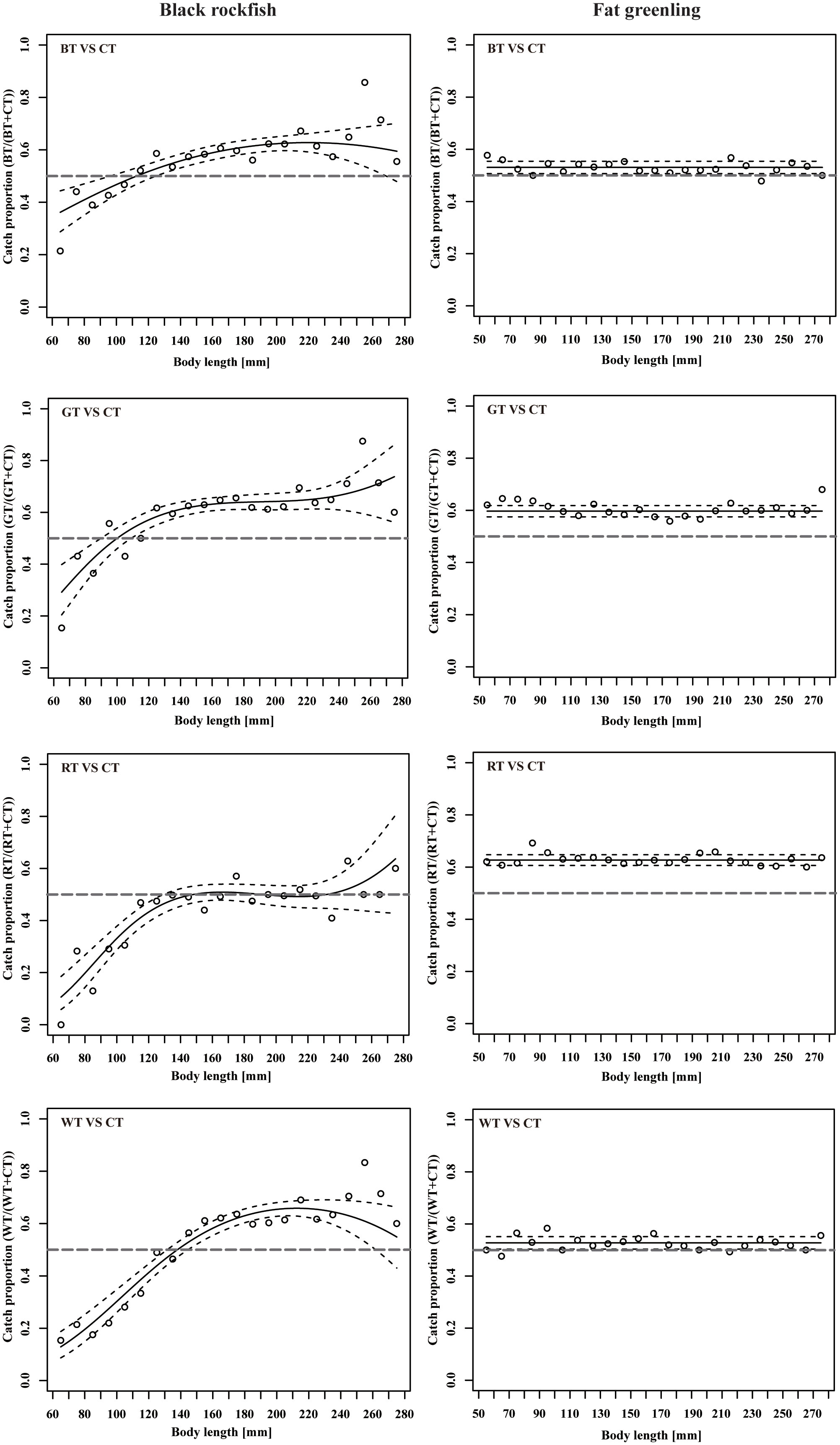
Figure 5 The GLMM-modeled proportions of two roundfish species captured in each body length class between the test trammel nets (BT, GT, RT, and WT) and control trammel net. CT, control trammel net; BT, blue-lighted trammel net; GT, green-lighted trammel net; RT, red-lighted trammel net; WT, white-lighted trammel net. The horizontal line of 0.5 indicates that catch was the same between the test and control trammel nets (no size-based selectivity). The solid black lines show the modeled means and the black dotted lines are the 95% confidence intervals.
Black rockfish
The BT, GT, and WT harvested significantly higher CPUE (21%-53%) than CT (p<0.001), while RT caught 14% fewer individuals, and this difference was significant (p=0.001; Table S2). The modeled catch rates of black rockfish for CT, BT, GT, RT, and WT were 10.31, 13.61, 15.77, 8.87, and 12.48, respectively (Table S2). The catch rate at Weihai was significantly lower than that at Rizhao, and no significant difference was found between Yantai and Rizhao. The modeled catch rates of black rockfish for Weihai and Yantai were 9.28 and 10.10, respectively.
Logit-quadratic curves provided the best fit for BT and WT and logit-cubic curves for GT and RT (Table S4). The modeled results showed that BT and WT caught more individuals at BL 130-270 mm and 145-260 mm than CT, respectively, and GT caught more individuals at BL >110 mm. For RT, the results showed no size selectivity for individuals at BL >130 mm, as the CIs overlap 0.5. A similar downward trend in catch rate for small-sized individuals was observed in all illuminated nets (Figure 5).
Fat greenling
The BT, GT, RT, and WT harvested significantly higher CPUE (12%-68%) than CT. The modeled catch rates of fat greenling for CT, BT, GT, RT, and WT were 6.13, 6.93, 9.07, 10.30, and 6.87, respectively (Table S2). The catch rates at Weihai and Yantai were significantly higher (34% and 61%) than at Rizhao. The modeled catch rates of fat greenling for Weihai and Yantai were 8.21 and 9.87, respectively.
Logit-constant curves provided the best fit for BT, GT, RT, and WT (Table S4). The modeled results showed that illuminated nets caught more individuals throughout the length class than CT (Figure 5).
Marbled flounder
The GT and RT harvested significantly higher CPUE (47% and 58%) than CT (p<0.001), while no significant difference was detected for BT and WT (Table S2). The modeled catch rates of marbled flounder for CT, BT, GT, RT, and WT were 9.97, 10.07, 14.66, 15.75, and 9.77, respectively (Table S2).
Logit-constant curves were the best fit for BT and WT, logit-linear curves for RT, and logit-quadratic curves for GT (Table S4). The modeled results showed no size selectivity for BT and WT throughout the length class, while the opposite effect for GT. There was no difference in catch rates for individuals at BL <160 mm, but individuals ≥160 mm were caught more by RT (Figure 6).

Figure 6 The GLMM-modeled proportions of two flatfish species captured in each body length class between the test trammel nets (BT, GT, RT, and WT) and control trammel net. CT, control trammel net; BT, blue-lighted trammel net; GT, green-lighted trammel net; RT, red-lighted trammel net; WT, white-lighted trammel net. The horizontal line of 0.5 indicates that catch was the same between the test and control trammel nets (no size-based selectivity). The solid black lines show the modeled means and the black dotted lines are the 95% confidence intervals.
Stone flounder
Similar to the results of marbled flounder, the GT and RT harvested significantly higher CPUE (40% and 62%) than CT (p<0.001), and no significant difference was observed for BT and WT (Table S2). The modeled catch rates of stone flounder for CT, BT, GT, RT, and WT were 11.82, 12.17, 16.55, 19.15, and 12.53, respectively (Table S2).
Logit-linear curves provided the best fit for BT, RT, and WT and logit-quadratic curves for GT (Table S4). The modeled results showed a significantly higher catch rate for RT across the length class, while no size selectivity difference was found for BT and WT. The GT caught more individuals at BL 120-240 mm, and no significant difference for other length classes (Figure 6).
Asian paddle crab
The GT harvested significantly higher CPUE (72%) than CT (p<0.001), while RT caught 23% fewer individuals (p<0.001; Table S3). The BT and WT caught slightly higher CPUE than CT, but this difference was insignificant. The modeled catch rates of Asian paddle crab for CT, BT, GT, RT, and WT were 10.42, 10.73, 17.92, 8.02, and 10.94, respectively (Table S3). There was no significant difference in catch rates among the three fishing areas. The modeled catch rates of Asian paddle crab for Weihai and Yantai were 9.69 and 9.79, respectively.
Logit-quadratic curves were the best fit for BT, RT, and WT, and logit-linear curves for GT (Table S5). The modeled results showed that BT, GT, and WT caught more individuals at CLs <37 mm, >35 mm, and >55 mm than CT, respectively, while no significant difference was found for other length classes. The RT caught more crabs at CLs >57 mm and fewer at CLs 30-57 mm (Figure 7).
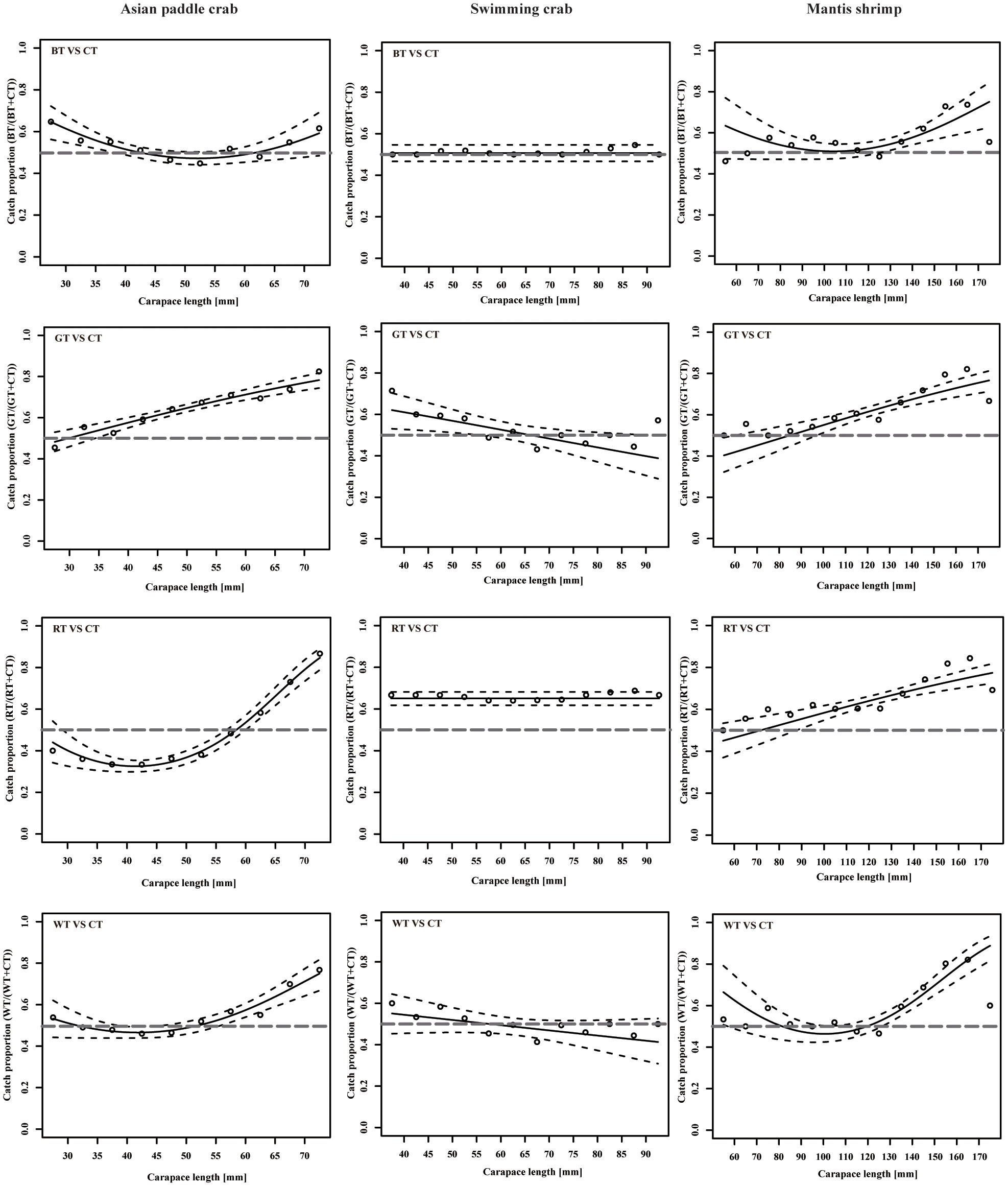
Figure 7 The GLMM-modeled proportions of three crustacean species captured in each carapace length class between the test trammel nets (BT, GT, RT, and WT) and control trammel net. CT, control trammel net; BT, blue-lighted trammel net; GT, green-lighted trammel net; RT, red-lighted trammel net; WT, white-lighted trammel net. The horizontal line of 0.5 indicates that catch was the same between the test and control trammel nets (no size-based selectivity). The solid black lines show the modeled means and the black dotted lines are the 95% confidence intervals.
Swimming crab
The RT harvested significantly higher CPUE (86%) than CT (p<0.001), while no significant difference was found for BT, GT, and WT (Table S3). The modeled catch rates of swimming crab for CT, BT, GT, RT, and WT were 8.94, 9.21, 9.57, 16.63, and 8.49, respectively (Table S3).
Logit-constant curves were the best fit for BT and RT and logit-linear curves for GT and WT (Table S5). The modeled results showed that RT caught more crabs than CT throughout the CLs, while no size selectivity was found for BT and WT. No difference in catch rates was observed for crabs at CLs >55 mm, but crabs ≤55 mm were caught more by GT (Figure 7).
Mantis shrimp
All illuminated nets harvested significantly higher CPUE than CT, ranging from 21%-78%. The modeled catch rates of mantis shrimp for CT, BT, GT, RT, and WT were 11.62, 14.06, 19.29, 20.68, and 14.64, respectively (Table S3). The modeled catch rate of mantis shrimp for Yantai was 9.41, which was significantly lower than Rizhao.
Logit-linear curves were the best fit for GT and RT and logit-quadratic curves for BT and WT (Table S5). The modeled results showed a similar trend of catch rates for all illuminated nets. No size selectivity was observed for small-sized shrimp, and the catch rates increased significantly with the increase of CLs (Figure 7).
VPUE analysis
Figure 8 illustrated the VPUE of different trammel net treatments in three fishing grounds. In general, the addition of different-colored LEDs significantly improved the economic benefits by 10%-74% of trammel nets compared with CT (p<0.05). In Rizhao, no significant difference was found for GT and RT (U=55, p=0.74), as well as BT and WT (U=60, p=0.99), while GT and RT provided significantly higher VPUE than BT and WT (GT vs. BT: U=0, p<0.001; GT vs. WT: U=121, p<0.001; RT vs. BT: U=0, p<0.001; RT vs. WT: U=121, p<0.001). In Weihai, significant differences in VPUE were observed for all treatment pairs (p<0.05). The sequence of the VPUE from higher to lower was GT, RT, WT, BT, and CT. In Yantai, GT provided significantly higher VPUE than other treatments (p<0.001). There were no significant differences among BT, RT, and WT (BT vs. RT: U=50, p=0.43; BT vs. WT: U=39, p=0.93; RT vs. WT: U=25, p=0.20). In summary, GT and RT provided the highest VPUE for Rizhao, while GT performed best in Weihai and Yantai (Figure 8).
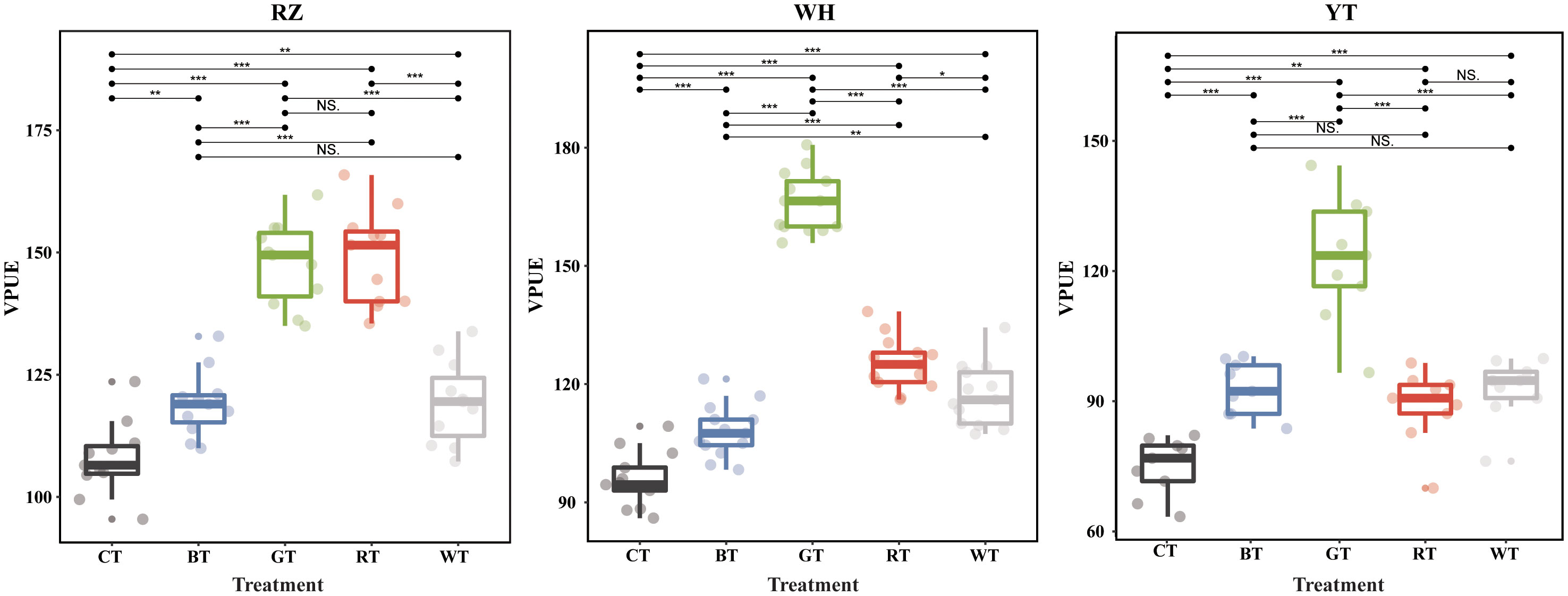
Figure 8 Comparison of VPUE among the LED treatment pairs in the three fishing grounds. CT, control trammel net; BT, blue-lighted trammel net; GT, green-lighted trammel net; RT, red-lighted trammel net; WT, white-lighted trammel net. RZ, Rizhao; WH, Weihai; YT, Yantai. Significance levels: NS. represents non-significant, * represents P <0.05, ** represents P <0.01, *** represents P <0.001.
Discussion
In this study, adding LEDs to trammel nets was shown to effectively increase the catch rates of seven commercial species and the economic benefits of this specific fishery. Over the past decades, artificial lights have been used as an effective tool to improve catch efficiency and selectivity of different fisheries worldwide (e.g., Bryhn et al., 2014; Nguyen et al., 2017; Nguyen et al., 2019; Cerbule et al., 2021; Ricci et al., 2022), while our study represents the first investigation on the effects of LEDs on catch rates in trammel net fisheries. The promising results suggested that light fishing techniques can serve as a viable and efficient method to improve catch rates and increase the profitability of fishermen in the Yellow Sea, China. Our study provided essential information for the renovation of the traditional fishing strategies.
Our results showed that the performance of LEDs varied across species and light colors, which has been confirmed by several studies (e.g., Marchesan et al., 2005; Luchiari and Pirhonen, 2008; Hannah et al., 2015). These studies reported that spectral sensitivity and behavioral responses to lights are species-specific. In general, the seven commercial species analyzed in this study exhibited positive phototaxis to red and green lights, except that black rockfish and Asian paddle crab posed repulsive responses towards red lights. The studied species showed similar responses to white and blue lights, which could be explained by the spectral profile of the white light containing a high proportion of blue wavelengths, although longer wavelengths were also present (Figure 3). Luo et al. (2006) studied the adaptation of compound eye of swimming crab to different wavelength lights and found that crabs were sensitive to red light, which was consistent with our results. Thoen et al. (2014) reported that stomatopod crustaceans (mantis shrimp) possessed a well-developed visual system with various photoreceptor types and exhibited spectral sensitivities to a wide range of wavelengths from 300 to 700 nm. They clarified that possessing efficient color recognition ability might be critical for the survival of mantis shrimp due to its rapid-fire lifestyle of combat and territoriality. These properties probably contribute to their preferences and aggregation to illuminated nets. However, these previous studies were conducted at a microscopic level, and practical application of artificial lights has never been tested in fishing practice to prove these results, although using artificial light as the stimulus source to attract and harvest fish has had a long history.
This study is the first attempt to assess the effects of artificial lights on these seven commercial species in field experiments, though the functional mechanisms of their reaction to illuminated nets during capture processes are not fully understood. In theory, each species has evolved over a long period to adapt to its ecological environment (e.g., depth, temperature, and water transparency) and prefers to aggregate in its optimal range of light wavelength and intensity (Johnson et al., 2002; Kuliñski and Styczyñska-Jurewicz, 2002; Nguyen and Winger, 2019). LEDs may provide a visual cue within the suitable sensitivity range that attracts target species to the illuminated nets. Meanwhile, spectral sensitivity and behavioral responses to lights are closely linked to species’ physiology, lifestyle, and feeding strategies (Arimoto et al., 2010). In some cases, aquatic species may feed on prey attracted by the lights, and lights enable predators to detect food more clearly (Bryh et al., 2014; Nguyen et al., 2017; Nguyen et al., 2019; Nguyen and Winger, 2019). For example, Humborstad et al. (2018) and Utne-Palm et al. (2018) reported that artificial light in baited pots substantially increases the catch of cod (Gadus morhua) by attracting important bait, krill (Thysanoessa inermis), although cod did not respond to artificial lights independently.
Water depth is a critical factor affecting the phototaxis of species, as lights with different wavelengths were selectively attenuated by different water layers (Nguyen and Winger, 2019). A persuasive hypothesis suggested by Clarke (1936) is that species’ visual pigment and sensitivity are matched to the spectral composition of light in its habitat. In our study, fat greenling is known to perform significant vertical migrations between day and night, from surface to bottom (Duan et al., 2015). This diel rhythm indicates that this species is naturally exposed to the different wavelengths of several depths in the water column. Therefore, fat greenling may be adaptive to a wide range of the spectrum, as shown by our results that higher catches were achieved in all illuminated nets compared with unilluminated nets (Table S2). Black rockfish and Asian paddle crab are benthic organisms inhabiting depths of 10-30 m. The long-wavelength red light is rapidly absorbed in this aquatic environment, while the shorter wavelength lights with high transmitting characteristics can penetrate into this water layer (Volpato and Barreto, 2001; Owen et al., 2010). Thus, black rockfish and Asian paddle crab exhibited negative phototaxis to the red light. In contrast, marbled flounder and stone flounder are widely distributed in the shallow waters of the Yellow Sea at depths of 5-12 m, which may provide a partial explanation for their positive phototaxis to red and green lights. In any case, more anatomical, electrophysiological, and behavioral studies in labs and in situ will provide detailed knowledge to explain the intrinsic mechanism of these species-specific behavioral response to lights.
The effects of LEDs on catch rates for certain species were found to be strongly size-dependent. For example, illuminated nets significantly decreased the catch rates of small-sized black rockfish while maintaining or improving the catch rates of medium- and large-sized individuals. No decrease in catch rates was found for large-sized individuals among the seven commercial species. Several studies have reported that spectral sensitivity and corresponding behavioral patterns varied across ontogeny (from embryo development to sexual maturation) (Marchesan et al., 2005; Nguyen et al., 2017; Nguyen and Winger, 2019). Cronin and Jinks (2001) also demonstrated that adult individuals have more complex visual systems than juveniles and conduct elaborate tasks (e.g., navigation, spatial vision, and prey recognition). Large-sized individuals may be attracted to illuminated nets as a means to enhance predation as mentioned above, resulting in smaller-sized individuals avoiding the adjacent area of illuminated nets or even being preyed on by conspecifics or competitors (Humborstad et al., 2018). Meanwhile, the size-dependent swimming ability may provide more opportunities for large-sized species to approach the vicinity of illuminated nets (Yu et al., 2021; Yu et al., 2022). We need further underwater video observation to verify these intraspecific and interspecific interactions.
The formulation of fishing strategies should consider confounding factors, such as the catch composition, species abundance, catch value, and seafood market preference in the fishing area. In the trammel net fishery, it is necessary to comprehensively consider the effects of LEDs on total economic benefits, and meanwhile take regional differences into consideration because of the discrepancy in the spatial distribution and abundance of species. For example, for the five commercial species that occurred in Weihai, the RT significantly improved the catch rates of fat greenling, marbled flounder, and stone flounder and performed better than BT, GT, and WT. However, the catch rates of black rockfish and Asian paddle crab were significantly reduced. Based on the comparison of different treatments, we recommended the application of GT in Weihai, which could improve the catch rates of all species and increase the VPUE most (74%). A similar situation existed for Yantai, and GT was the best option, which increased the VPUE by 63%. In Rizhao, GT improved the catch rates of all species, except for swimming crab. The RT significantly reduced the catch rates of black rockfish and Asian paddle crab by 14% and 23%, respectively; however, it harvested higher CPUE for fat greenling, swimming crab, and mantis shrimp than GT. By comparing VPUE, both GT and RT are equally suitable for application in Rizhao. There was a difference in the recommendation of LED treatments between Rizhao and other fishing grounds. This was caused by the discrepancy in community structure. Swimming crab was only captured in Rizhao and exhibited positive responses to red lights. In Rizhao, RT significantly improved the catch rates of this species by 86%. According to the local seafood market survey, the price of swimming crab was greatly higher than other commercial species (Table S1). Thus, swimming crab was the major contributor to the equivalent status of RT and GT in Rizhao, as well as the differences between Rizhao and other fishing grounds.
Ease of use and low cost in addition to improving interest are major factors to promote the local fishermen to adopt the new gear modifications (Wang et al., 2013; Senko et al., 2022). In trammel net fishery, LEDs are relatively convenient to install on the float lines and can remain illuminated throughout several trials without replacing the battery. Meanwhile, the operational mode of illuminated nets is identical to conventional nets; thus, no professional training is required for adoption by fishermen. Some previous studies have reported that the economic benefits of adopting LEDs in specific fisheries remained unclear given the high investment in LEDs, although the catchability of target species was increased to some extent (Nguyen and Winger, 2018; Nguyen et al., 2019). In this study, the price of domestically manufactured LED lights is low (8 yuan/light), which is negligible compared with the increase in incomes. Therefore, it is unnecessary for fishermen to consider the break-even point. Furthermore, the low price of LED lights will not cause the financial burden of the initial capital investment for fishermen. These advantages can make the impetus for uptake of this innovative fishing technique by trammel net fisheries and similar fisheries on a large scale.
Although LED lights significantly improved the catch rates for commercial species and trammel profits in the coastal communities of the Yellow Sea, the potential negative impacts of the application of this technology should be fully taken into consideration. The improvement in CPUE may increase the risk of overfishing and result in the depletion of fishery resources in the long-term consideration. The high exploitation rates of stocks would affect energy and material flow characteristics of ecosystems and damage ecosystem balance. Previous studies have demonstrated that the lack of regulations on fishing activities and the control of technological advancements could lead to the overexploitation of stocks and damage the service function of ecosystem (Mgana et al., 2019; Ricci et al., 2022). In coastal China, MOA has formulated and organized a series of management and conservation measures for rational exploitation of the commercial species. Firstly, MOA has implemented a “Double Control” system (referring to control the total number and engine power of marine fishing vessels as well as limit the total marine landings to 10 million tons) to control fishing efforts (Shen and Heino, 2014). Secondly, SMMF was enforced from May 1st to September 1st to protect the spawning stocks, which was useful to help reproductive success and support recruitment (Fang et al., 2022). Thirdly, many fishery administration departments and fishery industries conducted stock enhancement for the commercial species analyzed in this study to increase maximum sustainable yield (MSY) and support the sustainable development of fishery resource (Chinese Ministry of Agriculture, 2022). Due to the controllable fishing press and resilience of commercial species, the application of LED lights in trammel nets might cause limited impacts on fishery resources. Additionally, compared with traditional large-scale fishing activities, the high-efficient fishing strategy could reduce the bycatch of juveniles and non-target species and energy consumption, which could be beneficial for biodiversity and environment conservation. Nevertheless, it remains critically important to systematically assess the cumulative effect of technological creep on fishery over a long period and properly manage the technological advancements (Palomares and Pauly, 2019). Our future study will focus on the MSY of common species and the fishing power of fleets as well as biodiversity and community structure to establish a long-term monitoring system for the sustainability of fishery resources and ecosystems in the Yellow Sea, China.
Conclusion
In this study, we tested the effect of different colored LEDs on the catch rates of seven commercial species in the Yellow Sea, China. The results showed that the effect of LEDs on catch rates was species-specific and size-dependent. In general, the catch rates of large-sized individuals were maintained or improved. Based on the analysis of economic benefits, trammel nets equipped with red and green LEDs were most appropriate for Rizhao, and green LEDs for Weihai and Yantai, which could increase the VPUE by 40%, 74%, and 63%, respectively. This study can serve as a reference to renovate fishing strategies in the small-scale trammel net fisheries in the Yellow Sea, China, and potentially be applied to other similar fisheries.
Data availability statement
The original contributions presented in the study are included in the article/Supplementary Material. Further inquiries can be directed to the corresponding author.
Author contributions
MY: conceptualization, investigation, methodology, formal analysis, writing the original draft, and review and editing of the original draft. CL: methodology, formal analysis, and review and editing of the original draft. LZ: investigation, methodology, and formal analysis. YT: conceptualization, funding acquisition, project administration, and review and editing of the original draft. All authors contributed to the article and approved the submitted version.
Funding
This study was supported by the Project of Marine and Fishery Technology Innovation of Shandong (No.2017HYCX007).
Conflict of interest
The authors declare that the research was conducted in the absence of any commercial or financial relationships that could be construed as a potential conflict of interest.
Publisher’s note
All claims expressed in this article are solely those of the authors and do not necessarily represent those of their affiliated organizations, or those of the publisher, the editors and the reviewers. Any product that may be evaluated in this article, or claim that may be made by its manufacturer, is not guaranteed or endorsed by the publisher.
Supplementary material
The Supplementary Material for this article can be found online at: https://www.frontiersin.org/articles/10.3389/fmars.2022.1036979/full#supplementary-material
References
Arimoto T., Glass C. W., Zhang X. (2010). “Fish vision and its role in fish capture,” in Behavior of marine fishes. (Oxford, UK: Blackwell Publishing Ltd.), (Oxford, UK), 25–44.
Bates D., Mächler M., Bolker B., Walker S., Christensen R. H. B., Singmann H., et al. (2017) Package ‘‘lme4’’. r package version 1.1-13. Available at: https://github.com/lme4/lme4/.
Bolker B. M., Brooks M. E., Clark C. J., Geange S. W., Poulsen J. R., Stevens M. H. H., et al. (2009). Generalized linear mixed models: a practical guide for ecology and evolution. Trends Ecol. Evol. 24, 127–135. doi: 10.1016/j.tree.2008.10.008
Bryhn A. C., Königson S. J., Lunneryd S.-G., Bergenius M. A. J. (2014). Green lamps as visual stimuli affect the catch efficiency of floating cod (Gadus morhua) pots in the Baltic Sea. Fish. Res. 157, 187–192. doi: 10.1016/j.fishres.2014.04.012
Cerbule K., Herrmann B., Grimaldo E., Grimsmo L., Vollstad J. (2021). The effect of white and green LED-lights on the catch efficiency of the barents Sea snow crab (Chionoecetes opilio) pot fishery. PLoS One 16, e0258272. doi: 10.1371/journal.pone.0258272
Chinese Ministry of Agriculture (2022) The 4th China ROK joint proliferation and release of fishery resources was held in yantai, China and mupu, south Korea. Available at: http://www.moa.gov.cn/.
Cronin T. W., Jinks R. N. (2001). ). ontogeny of vision in marine crustaceans. Am. Zool. 41, 1098–1107. doi: 10.1093/icb/41.5.1098
Darquea J. J., Ortiz-Alvarez C., Córdova-Zavaleta F., Medina R., Bielli A., Alfaro-Shigueto J., et al. (2020). Trialing net illumination as a bycatch mitigation measure for sea turtles in a small-scale gillnet fishery in Ecuador. Lat. Am. J. Aquat. Res. 48, 446–455. doi: 10.3856/vol48-issue3-fulltext-2428
Duan Y., Dong J., Li M. (2015). Research progress in reproductive behavior of greenlings (Hexagrammida: Hexagrammos). Fish. Sci. China 34, 726–732.
Fabi G., Sbrana M., Biagi F., Grati F., Leonori I., Sartor P. (2002). Trammel net and gill net selectivity for lithognathus mormyrus (L. 1758), diplodus annularis (L. 1758) and mullus barbatus (L. 1758) in the Adriatic and ligurian seas. Fish. Res. 54, 375–388. doi: 10.1016/S0165-7836(01)00270-3
Fang G., Yu H., Wang X., Sheng H., Tang Y., Liu C., et al. (2022). Impact of summer moratorium on set-net fishery in haizhou bay, China. J. Oceanol. Limnol. 40, 1678–1691. doi: 10.1007/s00343-021-0479-1
FAO (2020). The state of world fisheries and aquaculture 2020. Sustainability in action. Rome, Italia. 206. doi: 10.4060/ca9229en
Fisheries Administration Bureau, MARA, and PRC (2017). 2017 China fishery statistics yearbooks (Beijing, China: Agricultural press).
Fisheries Administration Bureau, MARA, and PRC (2022). 2022 China fishery statistics yearbooks (Beijing, China: Agricultural press).
Gabr M. H., Mal A. O. (2016). Trammel net size-selectivity for hipposcarus harid (Forsskål 1775) and lethrinus harak (Forsskål 1775) in coral reef fisheries of jeddah, Saudi arabia. Egypt. J. Aquat. Res. 42, 491–498. doi: 10.1016/j.ejar.2016.09.005
Hannah R. W., Lomeli M. J. M., Jones S. A. (2015). Tests of artificial light for bycatch reduction in an ocean shrimp (Pandalus jordani) trawl: Strong but opposite effects at the footrope and near the bycatch reduction device. Fish. Res. 170, 60–67. doi: 10.1016/j.fishres.2015.05.010
Harris H. E., Fogg A. Q., Gittings S. R., Ahrens R. N. M., Allen M. S., Patterson III, W. F. (2020). Testing the efficacy of lionfish traps in the northern gulf of Mexico. PLoS One 15, e0230985. doi: 10.1371/journal.pone.0230985
Holst R., Revill A. (2009). ). a simple statistical method for catch comparison studies. Fish. Res. 95, 254–259. doi: 10.1016/j.fishres.2008.09.027
Humborstad O.-B., Utne-Palm A. C., Breen M., Løkkeborg S. (2018). Artificial light in baited pots substantially increases the catch of cod (Gadus morhua) by attracting active bait, krill (Thysanoessa inermis). ICES J. Mar. Sci. 75, 2257–2264. doi: 10.1093/icesjms/fsy099
Johnson M. L., Gaten E., Shelton M. J. (2002). Spectral sensitivities of five marine decapod crustaceans and a review of spectral sensitivity variation in relation to habitat. J. Mar. Biol. Ass. U.K. 82, 835–842. doi: 10.1017/S0025315402006203
Kalayci F., Yesilcicek T. (2012). Investigation of the selectivity of trammel nets used in red mullet (Mullus barbatus) fishery in the Eastern black Sea, turkey. Turk. J. Fish. Aquat. Sci. 12, 937–945. doi: 10.4194/1303-2712-v12_4_21
Karakulak F. S., Erk H. (2008). Gill net and trammel net selectivity in the northern Aegean Sea, Turkey. Sci. Mar. 72, 527–540. doi: 10.3989/scimar.2008.72n3527
Kuliñski W., Styczyñska-Jurewicz E. (2002). Light spectrum preference in the European eel Anguilla Anguilla (L.). Arch. Pol. Fish. 10, 167–175. doi: 10.9774/GLEAF.978-1-909493-38-4_2
Li X., Guo R., You Z., Zhu J., Sun S. (2019). Fishing capacity comparison of different types of gillnets in the yellow Sea. Fish. Sci. China 38, 452–457.
Li X., Wu Y., You Z., Zhang H., Sun S., Sun Z., et al. (2016). Analysis on the the catch composition by trammel net and its fishing performance for oratosquilla oratoria in the bohai Sea. Mar. Fish. China 38, 516–524.
Lucchetti A., Virgili M., Petetta A., Sartor P. (2020). An overview of gill net and trammel net size selectivity in the Mediterranean Sea. Fish. Res. 230, 105677. doi: 10.1016/j.fishres.2020.105677
Luchiari A. C., Pirhonen J. (2008). Effects of ambient colour on colour preference and growth of juvenile rainbow trout oncorhynchus mykiss (Walbaum). J. Fish Biol. 72, 1504–1514. doi: 10.1111/j.1095-8649.2008.01824.x
Luo Y., Shen C., Qian Z., Zhang H. (2006). The ultrastructure of compound eye in the portunus trituberculatus under different wavelength lights adaptation. J. Mole. Cel. Biol. China 39, 178–184.
Ma K., Huang L., Liu C., Zhang J. (2021). Analysis on the changes of china’s marine fishing industry in the forty years after reform and opening-up. Chin. Fish. Econ. 3, 1–10.
Marchesan M., Spoto M., Verginella L., Ferrero E. A. (2005). Behavioural effects of artificial light on fish species of commercial interest. Fish. Res. 73, 171–185. doi: 10.1016/j.fishres.2004.12.009
Mgana H., Kraemer B. M., O’Reilly C. M., Staehr P. A., Kimirei I. A., Apse C., et al. (2019). Adoption and consequences of new light-fishing technology (LEDs) on lake Tanganyika, East Africa. PLoS One 14, e0216580. doi: 10.1371/journal.pone.0216580
Nguyen K. Q., Humborstad O.-B., Løkkeborg S., Winger P. D., Bayse S. M. (2019). Effect of light-emitting diodes (LEDs) on snow crab catch rates in the barents Sea pot fishery. ICES J. Mar. Sci. 76, 1893–1901. doi: 10.1093/icesjms/fsz062
Nguyen K. Q., Winger P. D. (2018). Location, orientation, and economic performance of low-powered LED lights inside snow crab traps in eastern Canada (Hirtshals, Denmark: International Council for the Exploration of the Sea-Food and Agriculture Organization of the United Nations Working Group on Fishing Technology and Fish Behaviour (WGFTFB).
Nguyen K. Q., Winger P. D. (2019). Artificial light in commercial industrialized fishing applications: A review. Rev. Fish. Sci. Aquac. 27, 106–126. doi: 10.1080/23308249.2018.1496065
Nguyen K. Q., Winger P. D., Morris C., Grant S. M. (2017). Artificial lights improve the catchability of snow crab (Chionoecetes opilio) traps. Aquac. Fish. 2, 124–133. doi: 10.1016/j.aaf.2017.05.001
Ortiz N., Mangel J., Wang J., Alfaro-Shigueto J., Pingo S., Jimenez A., et al. (2016). Reducing green turtle bycatch in small-scale fisheries using illuminated gillnets: the cost of saving a sea turtle. Mar. Ecol. Prog. Ser. 545, 251–259. doi: 10.3354/meps11610
Owen M. A. G., Davies S. J., Sloman K. A. (2010). Light colour influences the behaviour and stress physiology of captive tench (Tinca tinca). Rev. Fish Biol. Fish. 20, 375–380. doi: 10.1007/s11160-009-9150-1
Palomares M. L. D., Pauly D. (2019). On the creeping increase of vessels’ fishing power. Ecol. Soc 24, 31. doi: 10.5751/ES-11136-240331
R Core Team (2018). R: A language and environment for statistical computing (Vienna, Austria: R Foundation for Statistical Computing). Available at: https://www.r-project.org.
Ricci P., Trivellin N., Cascione D., Cipriano G., Orlandi V. T., Carlucci R. (2022). Benefits and risks of the technological creep of LED light technologies applied to the purse seine fishery. Biology 11, 48. doi: 10.3390/biology11010048
Senko J. F., Peckham S. H., Aguilar-Ramirez D., Wang J. H. (2022). Net illumination reduces fisheries bycatch, maintains catch value, and increases operational efficiency. Curr. Biol. 32, 911–918.e2. doi: 10.1016/j.cub.2021.12.050
Shen G., Heino M. (2014). An overview of marine fisheries management in China. Mar. Policy 44, 265–272. doi: 10.1016/j.marpol.2013.09.012
Sun S., Li X., Li Y., Li J., Chen R., Zheng S. (2018). Analysis of fishery structure of trammel net in the coastal regions along the yellow Sea and the bohai Sea. Mar. Fish. China 40, 76–87.
Thoen H. H., How M. J., Chiou T.-H., Marshall J. (2014). A different form of color vision in mantis shrimp. Science 343, 411–413. doi: 10.1126/science.1245824
Utne-Palm A. C., Breen M., Løkkeborg S., Humborstad O.-B. (2018). Behavioural responses of krill and cod to artificial light in laboratory experiments. PloS One 13, e0190918. doi: 10.1371/journal.pone.0190918
Volpato G. L., Barreto R. E. (2001). Environmental blue light prevents stress in the fish Nile tilapia. braz. J. Med. Biol. Res. 34, 1041–1045. doi: 10.1590/S0100-879X2001000800011
Wang J., Barkan J., Fisler S., Godinez-Reyes C., Swimmer Y. (2013). Developing ultraviolet illumination of gillnets as a method to reduce sea turtle bycatch. Biol. Lett. 9, 20130383. doi: 10.1098/rsbl.2013.0383
Wang J., Fisler S., Swimmer Y. (2010). Developing visual deterrents to reduce sea turtle bycatch in gill net fisheries. Mar. Ecol. Prog. Ser. 408, 241–250. doi: 10.3354/meps08577
Whitmarsh D., Santos M. N., Ramos J., Monteiro C. C. (2008). Marine habitat modification through artificial reefs off the Algarve (southern portugal): An economic analysis of the fisheries and the prospects for management. Ocean Coast. Manage. 51, 463–468. doi: 10.1016/j.ocecoaman.2008.04.004
Yu M., Liu C., Tang Y., Zhang L., Zhao W. (2022). Effects of escape vents on the size selection of whelk (Rapana venosa) and Asian paddle crab (Charybdis japonica) in the small-scale pot fishery of the yellow Sea, China. Hydrobiologia 849, 3101–3115. doi: 10.1007/s10750-022-04899-5
Keywords: trammel net, LEDs, catch efficiency, mixed-species, small-scale fishery, VPUE
Citation: Yu M, Liu C, Zhang L and Tang Y (2022) Application of light-emitting diodes (LEDs) fishing lights to improve catch rates of small-scale trammel net fishery in the Yellow Sea, China. Front. Mar. Sci. 9:1036979. doi: 10.3389/fmars.2022.1036979
Received: 05 September 2022; Accepted: 10 November 2022;
Published: 28 November 2022.
Edited by:
Ole Ritzau Eigaard, Technical University of Denmark, DenmarkCopyright © 2022 Yu, Liu, Zhang and Tang. This is an open-access article distributed under the terms of the Creative Commons Attribution License (CC BY). The use, distribution or reproduction in other forums is permitted, provided the original author(s) and the copyright owner(s) are credited and that the original publication in this journal is cited, in accordance with accepted academic practice. No use, distribution or reproduction is permitted which does not comply with these terms.
*Correspondence: Yanli Tang, dGFuZ3lhbmxpQG91Yy5lZHUuY24=
 Mengjie Yu
Mengjie Yu Changdong Liu
Changdong Liu Yanli Tang
Yanli Tang